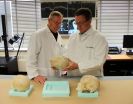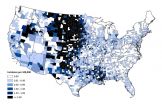Fragments of tRNA suggest a novel mechanism for cancer progression
2015-05-07
(Press-News.org) For years, scientists have been puzzled by the presence of short stretches of genetic material floating inside a variety of cells, ranging from bacteria to mammals, including humans. These fragments are pieces of the genetic instructions cells use to make proteins, but are too short a length to serve their usual purpose. Reporting in this week's Cell, researchers at Rockefeller have discovered a major clue to the role these fragments play in the body -- and in the process, may have opened up a new frontier in the fight against breast cancer.
Specifically, Sohail Tavazoie and his colleagues discovered that these particular genetic fragments, of a type of RNA known as transfer RNA (or tRNA), appear to be capable of reducing the growth and spread of breast cancer cells. "This is a new basic mechanism the body uses to control the growth of cancer," says Tavazoie, Leon Hess Associate Professor and head of the Elizabeth and Vincent Meyer Laboratory of Systems Cancer Biology. "We plan to explore it further, so hopefully it will open up new ways of curbing cancer that we have never tried before and reveal new basic insights on how genes are regulated inside our cells."
Scientists have found tRNA fragments in all walks of life, and they consistently increase in number when cells are exposed to low oxygen levels and other forms of cellular stress. But their purpose in the body has remained mysterious. "What those fragments are there for, and their role, is poorly defined," says Tavazoie.
The research, led by postdoctoral fellow Hani Goodarzi, discovered that breast cancer cells generate tRNA fragments when exposed to low levels of oxygen. And cancer cells that carry more of these particular genetic fragments are less likely to metastasize. What's more, adding these fragments to cells reduced the growth and progression of cancer; blocking the fragments, in turn, led to the opposite effect.
Looking closer, the researchers saw that tRNA fragments that come from specific tRNAs (glutamic acid, aspartic acid, glycine, tyrosine) bind to a key player in the life cycle of a cancer cell. This key player, known as an oncogene, normally binds to other RNAs and increases their numbers, causing them to make more of the oncogenes that help cancer cells divide and spread. "These tRNA fragments bind the oncogene -- called YBX1 -- and push out the other RNAs that encode for oncogenes, reducing cancer cells' ability to grow and metastasize. By doing so, they represent a new class of molecules in the cell we call tumor suppressors," says Goodarzi.
These tRNA fragments are demonstrating an entirely novel way of regulating gene expression, Tavazoie says. By blocking YBX1's ability to bind other RNAs whose expression YBX1 increases, tRNA fragments are playing a part in how the body expresses genes.
It makes sense that the number of tRNA fragments would increase in periods of cellular stress, such as when the cell is exposed to low oxygen levels, says Tavazoie. "Cells can sense whether they don't have sufficient energetic currency that occurs during low oxygen states, and tRNA fragments help suppress cells' growth rate so they can preserve their energy and nutrients for when the stress resolves."
Of course, aggressive breast cancer cells often find ways to sidestep the body's efforts to control them, including those involving these tRNA fragments. "We're very interested in figuring out how aggressive breast cancer cells stop the production of tRNA fragments," Tavazoie says. "It's exciting that these cancer cells are revealing a completely new way by which expression of oncogenes is regulated as a means of controlling cancer growth."
INFORMATION:
ELSE PRESS RELEASES FROM THIS DATE:
2015-05-07
Every inch of our body, inside and out, is oozing with bacteria. In fact, the human body carries 10 times the number of bacterial cells as human cells. Many are our friends, helping us digest food and fight off infections, for instance. But much about these abundant organisms, upon which our life depends, remains mysterious. In research reported May 7 in Cell, scientists at Rockefeller finally crack the code of a fundamental process bacteria use to defend themselves against invaders.
For years, researchers have puzzled over conflicting results about the workings of a ...
2015-05-07
EAST LANSING, Mich. - Much like a finger leaves its own unique print to help identify a person, researchers are now discovering that skull fractures leave certain signatures that can help investigators better determine what caused the injury.
Implications from the Michigan State University research could help with the determination of truth in child abuse cases, potentially resulting in very different outcomes.
Until now, multiple skull fractures meant several points of impact to the head and often were thought to suggest child abuse.
Roger Haut, a University Distinguished ...
2015-05-07
PULLMAN, Wash.--Washington State University researchers say the popularity of bamboo landscaping could increase the spread of hantavirus, with the plant's prolific seed production creating a population boom among seed-eating deer mice that carry the disease.
Richard Mack, an ecologist in WSU's School of Biological Sciences, details how an outbreak could happen in a recent issue of the online journal PLOS One.
Bamboo plants are growing in popularity, judging by the increased number of species listed by the American Bamboo Society. Some grow in relatively self-contained ...
2015-05-07
WASHINGTON -- Can a true, robust global health framework be created to help prevent tragedies like Ebola while at the same time allow countries to meet everyday health needs?
Georgetown University global health and law experts say it can be done, and in a special issue of "The Lancet" focusing on global health security, they propose specific priorities to transform a fragmented health system into a "purposeful, organized" framework with national health systems at its foundation and an empowered World Health Organization at its apex.
"The Ebola epidemic in west Africa ...
2015-05-07
The west African Ebola epidemic has rekindled interest in global health security, but it has also highlighted a troubling lack of political commitment to public health, and it is far from clear whether the crisis will be enough to rejuvenate global health security, say leading global health experts writing in The Lancet.
Through a series of essays [1], the review, which is published as part of a special issue on global health security, explores different perspectives on the wider lessons that can be drawn from the outbreak, including how it has demonstrated the importance ...
2015-05-07
Your genes may influence how sensitive you are to emotional information, according to new research by a UBC neuroscientist. The study, recently published in The Journal of Neuroscience, found that carriers of a certain genetic variation perceived positive and negative images more vividly, and had heightened activity in certain brain regions.
"People really do see the world differently," says lead author Rebecca Todd, a professor in UBC's Department of Psychology. "For people with this gene variation, the emotionally relevant things in the world stand out much more."
The ...
2015-05-07
For faster, longer-lasting water filters, some scientists are looking to graphene --thin, strong sheets of carbon -- to serve as ultrathin membranes, filtering out contaminants to quickly purify high volumes of water.
Graphene's unique properties make it a potentially ideal membrane for water filtration or desalination. But there's been one main drawback to its wider use: Making membranes in one-atom-thick layers of graphene is a meticulous process that can tear the thin material -- creating defects through which contaminants can leak.
Now engineers at MIT, Oak Ridge ...
2015-05-07
BOULDER--New research has identified correlations between weather conditions and the occurrence of West Nile virus disease in the United States, raising the possibility of being able to better predict outbreaks.
The study, by researchers with the National Center for Atmospheric Research (NCAR) and the Centers for Disease Control and Prevention (CDC), finds strong correlations across much of the country between an increased occurrence of West Nile virus disease and above average temperatures in the preceding year. The scientists also find that precipitation influences ...
2015-05-07
Latin American women in Los Angeles County are twice as likely as white women to contract cervical cancer, according to the Los Angeles County Department of Public Health, and are significantly less likely to be educated about the causes of the disease or to be screened for it.
That needs to change, say USC researchers, who are finding ways to make it happen.
"Latinas are the ones most at risk and yet health communication campaigns still essentially target white women," said Sheila Murphy, professor at the USC Annenberg School for Communication and Journalism.
Murphy ...
2015-05-07
Researchers at the RIKEN Brain Science Institute have uncovered a new mechanism for the regulation of blood pressure. Published in Molecular Cell, the study links events at the single-cell level to a system-level effect, showing that blood pressure can drop dramatically if the protein ERAP1 is released from cells and enters the blood stream.
Because high blood pressure is a primary risk factor for stroke, heart disease, and diabetes, understanding how our bodies naturally regulate blood pressure is essential for developing treatments that help keep it at normal levels. ...
LAST 30 PRESS RELEASES:
[Press-News.org] Fragments of tRNA suggest a novel mechanism for cancer progression

